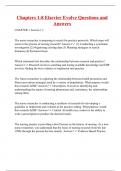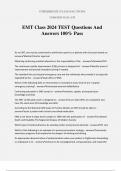Chapter 1: scope of marketing for new realities
Marketing is the activity, set of institutions, and processes for creating, communicating, delivering, and
exchanging offerings that have value for customers, clients, partners, and society at large. (Idea behind: four p’s)
In short: meeting needs profitably.
Aim of marketing: to know and understand the customer so well, that the product or service fits him and sells
itself.
How to create costumer value? about sensing what is the underlying customer needs and wants, sometimes
better than customers themselves.
Marketing management: is the art and science of choosing target markets and getting, keeping, and growing
customers through creating, delivering, and communicating superior customer value.
Marketers market 10 main types of entities: goods, services, events, experiences, persons, places, properties,
organizations, information, and ideas.
A marketer is someone who seeks a response from another party, called the prospect. If two parties are
seeking to sell something to each other, we call them both marketers.
Marketers use the term market to describe customer groups. Four key customer markets are consumer,
business, global, and nonprofit.
Core marketing concepts:
1. Needs, Wants, and Demands:
Needs: the basic human requirements such as for air, food, water, clothing, and shelter.
Five types of needs: stated needs, real needs, unstated needs, delight needs, secret needs.
Needs become wants when directed to specific objects that might satisfy the need.
Demands are wants for specific products backed by an ability to pay.
2. Target markets, Positioning and Segmentation:
Marketers identify distinct segments of buyers by identifying demographic, psychographic, and behavioral
differences between them. They then decide which segment(s) present the greatest opportunities. For each of
these target markets, the firm develops a market offering that it positions in target buyers’ minds as delivering
some key benefit(s).
3. Offering and Brands:
Value proposition: a set of benefits that satisfy those needs. The intangible value proposition is made physical
by an offering, which can be a combination of products, services, information, and experiences. A brand is an
offering from a known source.
4. Marketing Channels:
A marketer uses three kinds of marketing channels:
1) Communication channels deliver and receive messages from target buyers.
For example: newspapers, magazines, radio, etc.
2) Distribution channels help display, sell, or deliver the physical product or service(s) to the buyer or user.
Direct through internet and indirect with distributors for example.
3) Service channels: are used to carry out transactions with potential buyers.
For example: warehouses, transportation companies, etc.
5. Paid, Owned, and Earned Media:
Three categories of communication options for interacting with customers:
1) Paid media: marketers show their ad or brand for a fee.
2) Owned media: communication channels marketers actually own, like a company or brand brochure.
,3) Earned media are streams in which consumers, the press, or other outsiders voluntarily communicate
something about the brand via word of mouth, or viral marketing methods.
6. Impressions and Engagement:
Marketers now think of three “screens” to reach consumers: TV, Internet, and mobile.
Impressions: occur when consumers view a communication. tracking the scope of a communication’s reach,
can be compared. Downside: don’t provide insight to the results of viewing communication.
Engagement is the extent of a customer’s attention and active involvement with a communication, which is
more likely to create value for the firm.
7. Value and satisfaction:
Value: the sum of the tangible and intangible benefits and costs.
Costumer value triad: quality, service, and price.
Satisfaction reflects a person’s judgment of a product’s perceived performance in relationship to expectations.
8. Supply chain:
The supply chain is a longer channel stretching from raw materials to components to finished products carried
to final buyers.
9. Competition:
Competition includes all the actual and potential rival offerings and substitutes a buyer might consider.
10. Marketing Environment:
The marketing environment consists of:
- Task environment: includes the actors engaged in producing, distributing, and promoting the offering.
These are the company, suppliers, distributors, dealers, and target customers.
- Broad environment: consists of six components: demographic environment, economic environment, social-
cultural environment, natural environment, technological environment, and political-legal environment.
There are three transformative forces:
1. Technology: new idea is that “sharing information is power”.
2. Globalization has made countries increasingly multicultural.
3. Social responsibility: poverty, pollution, water shortages, climate change, wars, and wealth concentration
demand our attention
Marketing management
philosophies/orientations:
Production concept:
production and distribution
efficiency, consumers prefer
products that are widely
available and inexpensive.
Product concept: continuous
product improvement.
Selling concept: transactions,
not relations.
Marketing concept: customer
focus, understanding needs and
wants. (Sense and respond)
Holistic marketing concept:
based on the development,
design, and implementation of marketing programs, processes, and activities that recognize their breadth
, and interdependencies everything matters in Marketing! And a broad, integrated perspective is often
necessary.
1. Relationship marketing aims to build mutually satisfying long term relationships with key constituents
in order to earn and retain their business.
Ultimate outcome: a unique company asset called a marketing network, consisting of the company and
its supporting stakeholders, with whom it has built mutually profitable business relationships.
2. Integrated marketing occurs when the marketer develops activities and programs to create,
communicate, and deliver value for consumer such that “the whole is greater than the sum of its parts.
Two key themes are that:
Many different marketing activities can create, communicate, and deliver value.
Marketers should design and implement each marketing activity with all other activities in mind.
3. Internal marketing: is the task of hiring, training, and motivating able employees who want to serve
customers well.
4. Performance marketing requires understanding the financial and nonfinancial returns to business and
society from marketing activities and programs.
Mix marketing Four Ps are: Product, Place, Promotion and Price.
Modern Marketing Management Four P’s:
- People: reflects internal marketing and employees are critical to marketing success and it reflects the fact
that marketers must view consumers as people to understand their lives more broadly and not just as
shoppers.
- Processes: all the creativity, discipline, and structure brought to marketing management.
- Programs are all the firm’s consumer-directed activities, encompassing the old four Ps as well as a range of
other marketing activities that might not fit as neatly into the old view of marketing.
- Performance reflects the range of possible outcome measures that have financial and nonfinancial
implications and implications beyond the company itself.
Four tasks that make up successful marketing management and marketing leadership:
1) Developing and implementing marketing strategies and plans
2) Capturing marketing insights
3) Connecting with customers
4) Building strong brands
Chapter 2: Marketing Strategies and Plans
The value creation and delivery sequence consist of three phases.
1. Choosing the value, marketers segment the market, select the appropriate target, and develop the offering’s
value positioning.
2. Providing the value through identifying specific product features, prices, and distribution.
3. Communicating the value by utilizing the Internet, advertising, sales force, and other communication tools to
announce and promote the product.
The value delivery process begins
before there is a product and
continues through development
and after launch.
Value chain a tool for identifying
ways to create more customer
value; nine strategically relevant
activities that create value and cost
in a specific business.
, Core competency has three characteristics:
It is a source of competitive advantage and makes a significant contribution to perceived customer benefits.
It has applications in a wide variety of markets.
It is difficult for competitors to imitate.
Marketers must prioritize strategic planning in three key areas:
1) Managing their businesses as an investment portfolio.
2) Assessing the market’s growth rate and the company’s position in that market.
3) Establishing a strategy.
Marketing plan: is the central instrument for directing and coordinating the marketing effort, operating at both
the strategic and tactical levels. Used for individual products, lines, brands, channels, segments.
- Strategic marketing plan lays out the target markets and the firm’s value proposition, based on an analysis
of the best market opportunities.
- Tactical marketing plan specifies the marketing tactics, including product features, promotion,
merchandising, pricing, sales channels, and service.
Contents:
Executive summary and table of contents
Situation analysis: current target markets (needs, trends, growth), product review, competitors, SWOT
(Pestel, 5 Forces, VRINE,), etc.
Marketing strategy: mission, marketing and financial objectives, target markets, positioning.
Marketing tactics: marketing program (4 P’s).
Financial projections (budgeting): sales and expense forecast, break-even analysis, risk analysis.
Implementation controls: goals and budgets per month or quarter are reviewed
All corporate headquarters undertake four planning activities:
1. Defining the corporate mission:
Mission statement: statement of what the organization exists to accomplish, which provides employees with a
shared sense of purpose, direction, and opportunity. For whom? For shareholders and business partners.
Two guidelines:
Peter Drucker’s classic questions – good mission statements:
1) What is our business?
2) Who is the customer?
3) What is the value to the customers?
4) What will our business be?
5) What should our business be?
Good mission statements:
1) Limited number of goals
2) Stress major policies & values
3) Define competitive spheres
4) Take a long-term view
5) Short, memorable, meaningful
2. Establishing strategic business units
Strategic business unit (SBU) a business that can be planned separately from the rest of the company, with its
own set of competitors and a manager responsible for strategic planning and profit performance. Three
characteristics:
1) It is a single business, or a collection of related businesses, that can be planned separately from the rest of
the company.
2) It has its own set of competitors.




